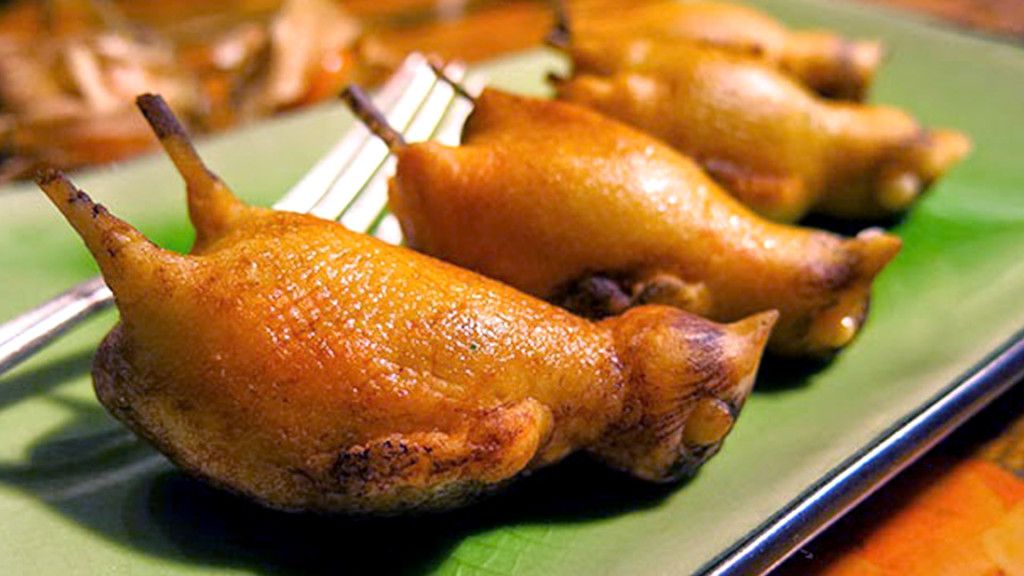Ortolan is a small, migratory songbird that was once considered a prized delicacy in French cuisine. The bird is typically cooked and eaten whole, with diners covering teir heads with a napkin while consuming it. While the consumption of ortolan has been restricted due to its declining population, it is still enjoyed by some who consider it a rare and special treat.
To prepare ortolan, the birds are typically caught in nets and then kept in a dark cage for several weeks. During this time, they are force-fed a diet of millet and figs, which causes them to put on weight and develop a layer of fat under their skin. This fat is what gives the bird its unique flavor and texture.
Once the birds have been fattened, they are typically drowned in Armagnac brandy and then plucked and roasted. To serve, the ortolan is typically placed on a slice of toast and then covered with a napkin, which is meant to trap the aromas of the dish and create a sense of anticipation for the diner.
When the diner is ready to eat, they remove the napkin and then consume the bird whole, bones and all. The first taste is said to be salty and savory with hazelnut overtones, followed by the rich, delicate flavor of the bird’s fat. Crunching on the tiny bones is also part of the experience, and is said to add to the overall texture and flavor of the dish.
While the consumption of ortolan has been restricted in recent years due to conservation efforts, some still seek out this rare and unique delicacy. Whether you consider it a culinary masterpiece or a controversial and unethical practice, there is no denying the cultural and historical significance of this iconic French dish.
Why Is Eating Ortolan Illegal?
Eating ortolan is illegal due to the endangered status of the bird’s population. Ortolan is a small songbird native to Europe, specifically France. The bird was a delicacy in French cuisine and was often cooked and consumed whole. The traditional way of eating it involves covering one’s head with a napkin or towel while consuming the bird, which is considered cruel and inhumane by animal rights activists.
The French government recognized the declining population of ortolan and passed laws restricting the bird’s use in cuisine in 1999. The bird is now a protected species uner the European Union’s Birds Directive, and hunting and selling it are illegal. Eating ortolan is considered a serious offense, and violators can face large fines and even imprisonment.
Eating ortolan is illegal due to the bird’s endangered status and the inhumane and cruel process of consuming it. The French government has passed strict laws to protect the bird, and violators can face severe consequences.

Why Is Ortolan Eaten Under A Napkin?
Ortolan is traditionally eaten under a napkin for a couple of reasons. Firstly, the napkin helps to capture and retain the aromas of the dish, which is considered an important part of the dining experience. Secondly, eating ortolan involves consuming the whole bird, including the bones, feet, and head, which can be quie messy and may require spitting out larger bones. The napkin helps to disguise this and allows the diner to discreetly dispose of any unwanted bits. the use of a napkin when eating ortolan is seen as a way to enhance the sensory experience while also maintaining an element of decorum.
Do Ortolans Taste Good?
Ortolans are highly prized by connoisseurs for their delicate and incomparable flavor. The first taste is delicious, with both salty and savory notes and hazelnut overtones. The fat from the ortolan also adds to the flavor profile, providing a unique taste experience. When eating ortolans, it is recommended to crunch the fine bones, as you would with barbecued sardines. the taste of ortolans is considered to be exceptional and is highly sought after by those who appreciate fine dining experiences.
How Much Does It Cost To Eat Ortolan?
According to The New York Times, a single ortolan bird is sold for around €150 ($180), which is roughly equivalent to the price of one ounce of white truffles. It is important to note that the consumption of ortolan is illegal in many countries, including France, due to its status as an endangered species. However, secret gatherings have been reported where the bird is served as a delicacy.
Conclusion
The ortolan recipe has a rich history in French cuisine, but its use has been restricted due to the endangerment of the bird’s population. Despite this, illegal sales and secret gatherings continue to occur. The traditional way of eating the bird involves covering one’s head with a napkin and eating it whole, bones and all, in a single bite. The first taste is said to be delicious with a unique flavor that is both salty and savory with hazelnut overtones. While the ortolan may be a delicacy, it is important to conider the impact on the environment and to make ethical choices in our consumption habits.
